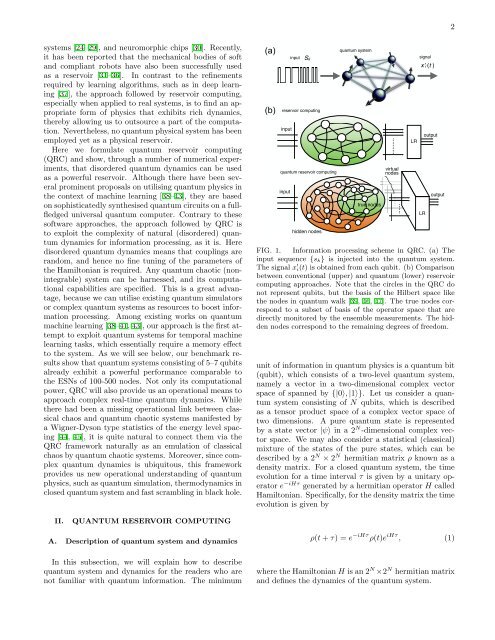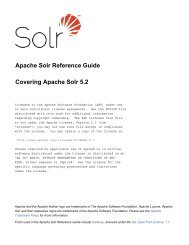Create successful ePaper yourself
Turn your PDF publications into a flip-book with our unique Google optimized e-Paper software.
2<br />
systems [24–29], and neuromorphic chips [30]. Recently,<br />
it has been reported that the mechanical bodies of soft<br />
and compliant robots have also been successfully used<br />
as a reservoir [31–36]. In contrast to the refinements<br />
required by learning algorithms, such as in deep learning<br />
[37], the approach followed by reservoir computing,<br />
especially when applied to real systems, is to find an appropriate<br />
form of physics that exhibits rich dynamics,<br />
thereby allowing us to outsource a part of the computation.<br />
Nevertheless, no quantum physical system has been<br />
employed yet as a physical reservoir.<br />
Here we formulate quantum reservoir computing<br />
(QRC) and show, through a number of numerical experiments,<br />
that disordered quantum dynamics can be used<br />
as a powerful reservoir. Although there have been several<br />
prominent proposals on utilising quantum physics in<br />
the context of machine learning [38–43], they are based<br />
on sophisticatedly synthesised quantum circuits on a fullfledged<br />
universal quantum computer. Contrary to these<br />
software approaches, the approach followed by QRC is<br />
to exploit the complexity of natural (disordered) quantum<br />
dynamics for information processing, as it is. Here<br />
disordered quantum dynamics means that couplings are<br />
random, and hence no fine tuning of the parameters of<br />
the Hamiltonian is required. Any quantum chaotic (nonintegrable)<br />
system can be harnessed, and its computational<br />
capabilities are specified. This is a great advantage,<br />
because we can utilise existing quantum simulators<br />
or complex quantum systems as resources to boost information<br />
processing. Among existing works on quantum<br />
machine learning [38–41, 43], our approach is the first attempt<br />
to exploit quantum systems for temporal machine<br />
learning tasks, which essentially require a memory effect<br />
to the system. As we will see below, our benchmark results<br />
show that quantum systems consisting of 5–7 qubits<br />
already exhibit a powerful performance comparable to<br />
the ESNs of 100-500 nodes. Not only its computational<br />
power, QRC will also provide us an operational means to<br />
approach complex real-time quantum dynamics. While<br />
there had been a missing operational link between classical<br />
chaos and quantum chaotic systems manifested by<br />
a Wigner-Dyson type statistics of the energy level spacing<br />
[44, 45], it is quite natural to connect them via the<br />
QRC framework naturally as an emulation of classical<br />
chaos by quantum chaotic systems. Moreover, since complex<br />
quantum dynamics is ubiquitous, this framework<br />
provides us new operational understanding of quantum<br />
physics, such as quantum simulation, thermodynamics in<br />
closed quantum system and fast scrambling in black hole.<br />
(a)<br />
(b)<br />
reservoir computing<br />
input<br />
quantum reservoir computing<br />
input<br />
input<br />
Sk<br />
1 Input<br />
0.8<br />
0.6<br />
0.4<br />
0.2<br />
0<br />
hidden nodes<br />
quantum system<br />
true nodes<br />
virtual<br />
nodes<br />
}<br />
LR<br />
signal<br />
x’i (t )<br />
LR<br />
output<br />
output<br />
FIG. 1. Information processing scheme in QRC. (a) The<br />
input sequence {s k } is injected into the quantum system.<br />
The signal x ′ i(t) is obtained from each qubit. (b) Comparison<br />
between conventional (upper) and quantum (lower) reservoir<br />
computing approaches. Note that the circles in the QRC do<br />
not represent qubits, but the basis of the Hilbert space like<br />
the nodes in quantum walk [39, 46, 47]. The true nodes correspond<br />
to a subset of basis of the operator space that are<br />
directly monitored by the ensemble measurements. The hidden<br />
nodes correspond to the remaining degrees of freedom.<br />
unit of information in quantum physics is a quantum bit<br />
(qubit), which consists of a two-level quantum system,<br />
namely a vector in a two-dimensional complex vector<br />
space of spanned by {|0〉, |1〉}. Let us consider a quantum<br />
system consisting of N qubits, which is described<br />
as a tensor product space of a complex vector space of<br />
two dimensions. A pure quantum state is represented<br />
by a state vector |ψ〉 in a 2 N -dimensional complex vector<br />
space. We may also consider a statistical (classical)<br />
mixture of the states of the pure states, which can be<br />
described by a 2 N × 2 N hermitian matrix ρ known as a<br />
density matrix. For a closed quantum system, the time<br />
evolution for a time interval τ is given by a unitary operator<br />
e −iHτ generated by a hermitian operator H called<br />
Hamiltonian. Specifically, for the density matrix the time<br />
evolution is given by<br />
II.<br />
QUANTUM RESERVOIR COMPUTING<br />
A. Description of quantum system and dynamics<br />
ρ(t + τ) = e −iHτ ρ(t)e iHτ , (1)<br />
In this subsection, we will explain how to describe<br />
quantum system and dynamics for the readers who are<br />
not familiar with quantum information. The minimum<br />
where the Hamiltonian H is an 2 N ×2 N hermitian matrix<br />
and defines the dynamics of the quantum system.



